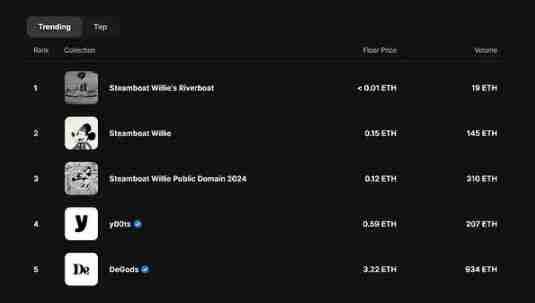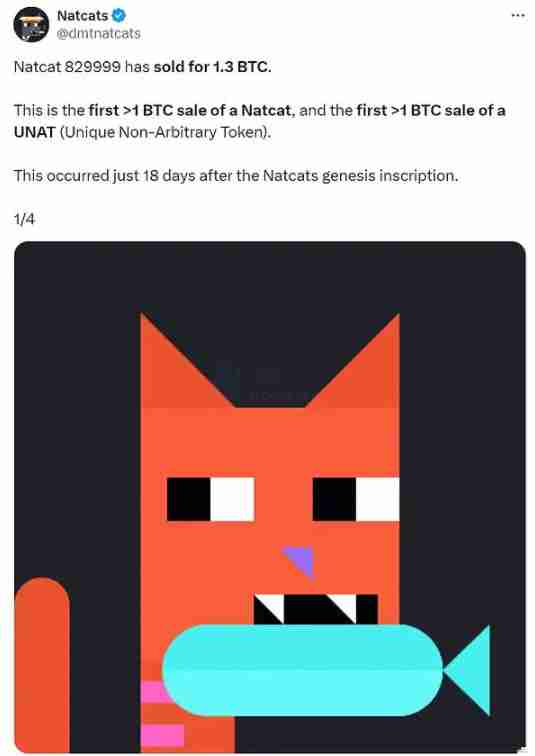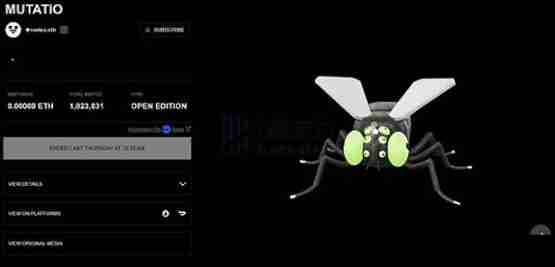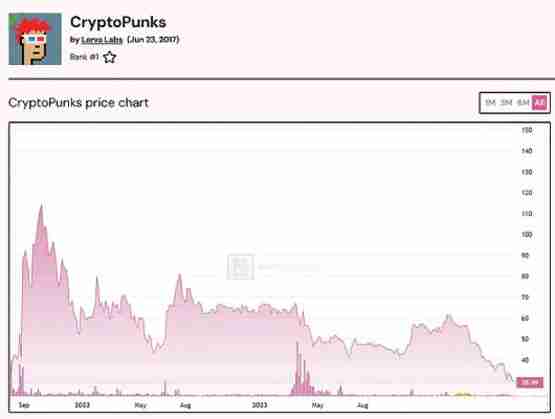NFT's 2024: Pictures who work hard and don't want to leave
Review of the NFT market in 2024: From "Three Points in the World" to the recovery at the end of the year
In 2024, the NFT market experienced a year of ups and downs. At the beginning of the year, Ethereum, Solana and Bitcoin (Ordinals) competed in three ways, but Ethereum still dominated with the advantages of its leading NFT projects. However, incidents such as Twitter canceling NFT avatar function once caused the market to be sluggish.
January: The curtain call of the hexagonal avatar
At the beginning of 2024, the Ethereum NFT market dominated OpenSea with "retro Mickey Mouse", but Twitter canceled the NFT avatar function, marking the end of the "hexagon avatar" era. Star projects emerging this month include Pizza Ninjas and RSIC of the Bitcoin Ordinals ecosystem, Ethereum projects Tinfun and ittybits, and Solana projects CryptoUndeads.


February: ERC-404 acquisition with Yuga Labs
The "Pandora's Box" project, which is standard for the ERC-404, emerged in February, and its prices soared. At the same time, Yuga Labs acquired Moonbirds development team PROOF, further consolidating its position as an industry giant, but also sparked discussions on its future development direction.

This month’s star project: Bitcoin Ordinals project Quantum Cats.
March: Blast main network is online and Runestone airdrop
On March 1, the Blast main network was launched. The Bitcoin Ordinals ecosystem continues to be popular, and the concept of "DMT" and Runestone airdrops have attracted market attention. The huge scale of Runestone airdrops has had a profound impact on the entire Bitcoin Ordinals ecosystem. However, Starbucks' NFT loyalty program shutdown and Kevin Rose's controversy also cast a shadow on the market.


The star projects of the month: Runestone, CENTS, Plutocats and Crypto Valley.
April: Bitcoin halving with Base NFT growth
Bitcoin halving event became the focus of April, and NFTs on the Base network also showed a growth trend. XCOPY's Open Edition series "MUTATIO" issued on Base and the derived Meme token $FLIES has sparked heated discussion. The "Friends Buy and Sell" game fantasy.top on the Blast network continues to be popular.

Star projects of the month: Blob and Prometheans.
May to June: Market downturn and rebound
Starting from May, the NFT market has entered a relatively downturn. CryptoPunks floor price fell below 30 ETH, and BAYC also fell sharply, marking the darkest moment in the market. However, at the end of June, the old Ethereum blue chip NFT project rebounded and the market began to recover. Meanwhile, Abstract (formerly Frame) was acquired by Pudgy Penguins parent company Igloo and rebranded.

Star projects of this month: Writ of Passage by The Beacon and Gigabud.
End of the year: Strong recovery
End of the year, Magic Eden token $ME airdrop and Pudgy Penguins token $PENGU airdrop brought significant wealth effects, and the market recovered strongly. Azuki also confirmed that it will issue coins. At the same time, NFT is becoming increasingly popular as a cold start method for projects, and many low-priced Free Mint projects emerge. On Solana's network, the popularity of meme coins has driven the NFT market.
The Clone X project announced the suspension of operations, which is a pity. Looking ahead, the Abstract main network is about to be launched, and other emerging public chains may also bring new opportunities. AI-related NFTs and more and more coin issuing projects choose NFT as a preheating method will shape a new pattern in the future NFT market.
In short, the NFT market has undergone a transition from a downturn to a recovery in 2024, with new narratives and patterns constantly emerging, while pictures are still the core of NFT. How will you evaluate the NFT market in 2024?
The above is the detailed content of NFT's 2024: Pictures who work hard and don't want to leave. For more information, please follow other related articles on the PHP Chinese website!

Hot AI Tools

Undresser.AI Undress
AI-powered app for creating realistic nude photos

AI Clothes Remover
Online AI tool for removing clothes from photos.

Undress AI Tool
Undress images for free

Clothoff.io
AI clothes remover

Video Face Swap
Swap faces in any video effortlessly with our completely free AI face swap tool!

Hot Article

Hot Tools

Notepad++7.3.1
Easy-to-use and free code editor

SublimeText3 Chinese version
Chinese version, very easy to use

Zend Studio 13.0.1
Powerful PHP integrated development environment

Dreamweaver CS6
Visual web development tools

SublimeText3 Mac version
God-level code editing software (SublimeText3)

Hot Topics
 Which of the top ten currency trading platforms in the world are the latest version of the top ten currency trading platforms
Apr 28, 2025 pm 08:09 PM
Which of the top ten currency trading platforms in the world are the latest version of the top ten currency trading platforms
Apr 28, 2025 pm 08:09 PM
The top ten cryptocurrency trading platforms in the world include Binance, OKX, Gate.io, Coinbase, Kraken, Huobi Global, Bitfinex, Bittrex, KuCoin and Poloniex, all of which provide a variety of trading methods and powerful security measures.
 How to use the chrono library in C?
Apr 28, 2025 pm 10:18 PM
How to use the chrono library in C?
Apr 28, 2025 pm 10:18 PM
Using the chrono library in C can allow you to control time and time intervals more accurately. Let's explore the charm of this library. C's chrono library is part of the standard library, which provides a modern way to deal with time and time intervals. For programmers who have suffered from time.h and ctime, chrono is undoubtedly a boon. It not only improves the readability and maintainability of the code, but also provides higher accuracy and flexibility. Let's start with the basics. The chrono library mainly includes the following key components: std::chrono::system_clock: represents the system clock, used to obtain the current time. std::chron
 Which of the top ten currency trading platforms in the world are among the top ten currency trading platforms in 2025
Apr 28, 2025 pm 08:12 PM
Which of the top ten currency trading platforms in the world are among the top ten currency trading platforms in 2025
Apr 28, 2025 pm 08:12 PM
The top ten cryptocurrency exchanges in the world in 2025 include Binance, OKX, Gate.io, Coinbase, Kraken, Huobi, Bitfinex, KuCoin, Bittrex and Poloniex, all of which are known for their high trading volume and security.
 How to measure thread performance in C?
Apr 28, 2025 pm 10:21 PM
How to measure thread performance in C?
Apr 28, 2025 pm 10:21 PM
Measuring thread performance in C can use the timing tools, performance analysis tools, and custom timers in the standard library. 1. Use the library to measure execution time. 2. Use gprof for performance analysis. The steps include adding the -pg option during compilation, running the program to generate a gmon.out file, and generating a performance report. 3. Use Valgrind's Callgrind module to perform more detailed analysis. The steps include running the program to generate the callgrind.out file and viewing the results using kcachegrind. 4. Custom timers can flexibly measure the execution time of a specific code segment. These methods help to fully understand thread performance and optimize code.
 What is real-time operating system programming in C?
Apr 28, 2025 pm 10:15 PM
What is real-time operating system programming in C?
Apr 28, 2025 pm 10:15 PM
C performs well in real-time operating system (RTOS) programming, providing efficient execution efficiency and precise time management. 1) C Meet the needs of RTOS through direct operation of hardware resources and efficient memory management. 2) Using object-oriented features, C can design a flexible task scheduling system. 3) C supports efficient interrupt processing, but dynamic memory allocation and exception processing must be avoided to ensure real-time. 4) Template programming and inline functions help in performance optimization. 5) In practical applications, C can be used to implement an efficient logging system.
 How to understand DMA operations in C?
Apr 28, 2025 pm 10:09 PM
How to understand DMA operations in C?
Apr 28, 2025 pm 10:09 PM
DMA in C refers to DirectMemoryAccess, a direct memory access technology, allowing hardware devices to directly transmit data to memory without CPU intervention. 1) DMA operation is highly dependent on hardware devices and drivers, and the implementation method varies from system to system. 2) Direct access to memory may bring security risks, and the correctness and security of the code must be ensured. 3) DMA can improve performance, but improper use may lead to degradation of system performance. Through practice and learning, we can master the skills of using DMA and maximize its effectiveness in scenarios such as high-speed data transmission and real-time signal processing.
 How to use string streams in C?
Apr 28, 2025 pm 09:12 PM
How to use string streams in C?
Apr 28, 2025 pm 09:12 PM
The main steps and precautions for using string streams in C are as follows: 1. Create an output string stream and convert data, such as converting integers into strings. 2. Apply to serialization of complex data structures, such as converting vector into strings. 3. Pay attention to performance issues and avoid frequent use of string streams when processing large amounts of data. You can consider using the append method of std::string. 4. Pay attention to memory management and avoid frequent creation and destruction of string stream objects. You can reuse or use std::stringstream.
 How to implement loosely coupled design in C?
Apr 28, 2025 pm 09:42 PM
How to implement loosely coupled design in C?
Apr 28, 2025 pm 09:42 PM
To implement loose coupling design in C, you can use the following methods: 1. Use interfaces, such as defining the Logger interface and implementing FileLogger and ConsoleLogger; 2. Dependency injection, such as the DataAccess class receives Database pointers through the constructor; 3. Observer mode, such as the Subject class notifies ConcreteObserver and AnotherObserver. Through these technologies, dependencies between modules can be reduced and code maintainability and flexibility can be improved.





